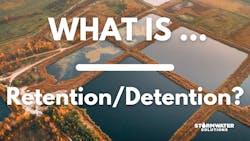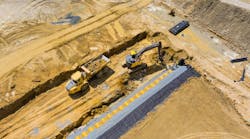What is retention?
Retention and detention are often used interchangeably, but they do have distinct differences.
Retention is the storage of stormwater runoff without subsequent surface discharge. Retention is also commonly used to describe practices that retain a runoff volume until it is displaced in part or in total by the runoff event from the next storm.
Retention systems maintain a significant permanent pool of water between runoff events.
When rain occurs the retention area can hold water until the next rain event which forces the stored water out. The incoming water will be stored in its place.
Retention areas can come in many forms including retention ponds, tanks, tunnels and underground vaults or pipes, as well as wetland basins.[1]
What is detention?
Detention is the practice of collecting water for temporary storage with the intention of subsequent release.
Detention systems do not retain a significant permanent pool of water between runoff events.
Examples of water detention include detention basins, underground vaults, tanks or pipes, and deep tunnels, as well as temporary detention in parking lots, roof tops and depressed grassy areas.
How do you retain stormwater runoff?
Capturing stormwater runoff can help wetlands and parks flourish, replenish groundwater supplies and provide additional water supplies for cities and residents.
Other benefits of stormwater capture include reduced heat island effects, increased flood protection, more green spaces, improved water quality and more habitat for plants and wildlife.
Infrastructure projects like rain gardens, bioswales, porous pavement, green roofs, rain barrels and green streets are all ways to capture stormwater runoff in developed areas.[2]
What is a water retention system?
A stormwater system is a tool for managing the runoff from rainfall.
Man-made stormwater systems were designed to mimic natural processes and come in a variety of shapes, sizes and forms.
They can be built as stormwater retention basins, stormwater swales, dry retention systems and wet detentions.
A stormwater retention basin is designed to store runoff for about 72 hours to allow water to seep through the soil into the shallow groundwater aquifer.
A stormwater swale is either man-made or natural areas shaped to allow water to be quickly absorbed into the ground or to allow the water to flow to other waterways.
Dry retention systems hold a certain amount of stormwater and through percolation dries.
Wet detention systems are designed to allow material to settle and be absorbed. After a storm, water drains from the ponds through an outflow pipe. Part of the pond, known as the permanent pool, is always below the level of the drain structure.[3]
What is the difference between retention and detention ponds?
A detention ponds temporarily stores stormwater runoff. The basin is designed to manage stormwater runoff by storing it and releasing it gradually until it is completely drained.
A retention basin or pond is designed to permanently hold water. Retention basins are used when the groundwater is near the surface of the ground. A retention basin will not have an outlet source. The water collected by a retention basin will either infiltrate the ground or evaporate.
A retention basin will have a higher removal of pollutants. Retention basins can also serve as an aesthetic or recreational amenity, as well as habitat for wildlife and vegetation. They can become their own ecosystem.
Resources
[1] https://www.epa.gov/sites/default/files/2015-11/documents/urban-stormwater-bmps_preliminary-study_1999.pdf
[2] https://gispublic.waterboards.ca.gov/portal/apps/storymaps/stories/3073c5b98ecb4f76969e50b3e9065a79
[3] https://www.sjrwmd.com/education/stormwater-systems/#:~:text=Retention%20systems%20are%20closed%20systems,to%20flow%20to%20other%20waterways.
About the Author
Alex Cossin
Associate Editor
Alex Cossin is the associate editor for Waterworld Magazine, Wastewater Digest and Stormwater Solutions, which compose the Endeavor Business Media Water Group. Cossin graduated from Kent State University in 2018 with a Bachelor of Science in Journalism. Cossin can be reached at [email protected].






